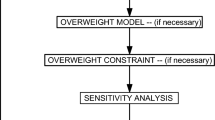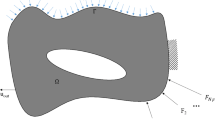Abstract
Topology optimization problems for compliant mechanisms using a density interpolation scheme, the rational approximation of material properties (RAMP) method, and a globally convergent version of the method of moving asymptotes (GCMMA) are primarily discussed. First, a new multi-objective formulation is proposed for topology optimization of compliant mechanisms, in which the maximization of mutual energy (flexibility) and the minimization of mean compliance (stiffness) are considered simultaneously. The formulation of one-node connected hinges, as well as checkerboards and mesh-dependency, is typically encountered in the design of compliant mechanisms. A new hybrid-filtering scheme is proposed to solve numerical instabilities, which can not only eliminate checkerboards and mesh-dependency efficiently, but also prevent one-node connected hinges from occurring in the resulting mechanisms to some extent. Several numerical applications are performed to demonstrate the validity of the methods presented in this paper.
Similar content being viewed by others
References
Ananthasuresh GK, Kota S, Gianchandani Y (1994) A methodical approach to the design of compliant micro-mechanisms. In: Technical Digest of the Solid-State Sensor and Actuator Workshop, Hilton Head Island, SC, June 13–16, 189–192
Bendsøe MP, Kikuchi N (1988) Generating optimal topology in structural design using a homogenization method. Comput Methods Appl Mech Eng 71:197–224
Bendsøe MP, Sigmund O (1999) Material interpolation schemes in topology optimization. Arch Appl Mech 69:635–654
Bendsøe MP, Sigmund O (2003) Topology optimization: theory, methods, and applications. Springer, Berlin Heidelberg New York
Borrvall T, Petersson J (2001) Topology optimization using regularized intermediate density control. Comput Methods Appl Mech Eng 190:4911–4928
Bourdin B (2001) Filters in topology optimization. Int J Numer Methods Eng 50:2143–2158
Diaz AR, Sigmund O (1995) Checkerboard patterns in layout optimization. Struct Optim 10:40–45
Duysinx P, Bendsøe O (1998) Topology optimization of continuum structures with local stress constraints. Int J Numer Methods Eng 43(1):1453–1478
Frecker MI, Ananthasuresh GK, Nishiwaki S Kikuchi N, Kota S (1997) Topological synthesis of compliant micromechnisms using multi-criteria optimization. J Mech Des 119:238–245
Haber RB, Bendsoe MP, Jog C (1996) A new approach to variable-topology shape design using a constraint on the perimeter. Struct Optim 11:1–12
Howell LL (2001) Compliant mechanisms. Wiley, New York
Howell LL, Midha A (1994) A method for design of compliant mechanisms with small length flexural pivots. Trans ASME 116:280–290
Larsen U, Sibmund O, Bouuwstra S (1997) Design and fabrication of compliant micro-mechanisms and structures with negative Poisson’s ratio. J Microelectromech Syst 6:99–106
Midha A, Norton TW, Howell LL (1992) On the nomenclature and classification of compliant mechanisms: the components of mechanisms, Proc. ASME Design Engineering Technical Conf., Arizona, 47:13–16
Nishiwaki S, Frecker MI, Min S, Kikichi N (1998) Topology optimization of compliant mechanisms using the homogenization method. Int J Numer Methods Eng 42:535–559
Rozvany GIN (1997) Topology optimization in structural mechanics. Springer, Berlin Heidelberg New York
Rozvany GIN (2001) Aims, Scope, history and unified terminology of computer-aided topology optimization. Struct Multidisc Optim 21:90–108
Rozvany GIN, Kirsch U, Bendsøe MP, Sigmund O (1995) layout optimization of structures. Appl Mech Rev 48:41–119
Pedersen CBW, Buhl T, Sigmund O (2001) Topology synthesis of large-displacement compliant mechanisms. Int J Numer Methods Eng 50:2683–2705
Petersson J, Sigmund O (1998) Slope constrained topology optimization. Int J Numer Methods Eng 41:1417–1434
Poulsen TA (2002a) A new scheme for imposing a minimum length scale in topology optimization: the mole method. DCAMM report 663
Poulsen TA (2002b) A simple scheme to prevent checkerboard patterns and one-node connected hinges in topology optimization. Struct Multidisc Optim 24:396–399
Sigmund O (1994) Design of numerical structures using topology optimization. Ph.D. thesis, Department of Solid Mechanics, Technical University of Denmark
Sigmund O (1997) On the design of compliant mechanisms using topology optimization. Mech Struct Mach 25(3):493–524
Sigmund O (2001) Design of multiphysics actuator using topology optimization—part I: one material structure. Comput Methods Appl Mech Eng 190(49–50):6577–6604
Sigmund O (2001) Design of multiphysics actuator using topology optimization—part II: two material structure. Comput Methods Appl Mech Eng 190(49–50), 6605–6627
Sigmund O, Petersson J (1998) Numerical instabilities in topology optimization: a survey on procedures dealing with checkerboards, mesh-dependencies and local minima. Struct Optim 16:68–75
Stolpe M, Svanberg K (2001) An alternative interpolation scheme for minimum compliance topology optimization. Struct Multidisc Optim 22:116–124
Svanberg K (1987) The method of moving asymptotes: a new method for structural optimization. Int J Numer Methods Eng 24:359–373
Svanberg K (2002) A class of globally convergent optimization methods based on conservative convex separable approximations, SIAM J Optim 12:555-573
Zhou M, Rozvany GIN (1991) The COC algorithm, part II: topological, geometry and generalized shape optimization. Comput Methods Appl Mech Eng 89:197–224
Yin L, Ananthasuresh GK (2003) Design of distributed compliant mechanism. Mech Based Des Struct Mach 31(1):269–279
Yoon GH, Kim YY, Bendsøe MP, Sigmund O (2004) Hinge-free topology optimization with embedded translation-invariant differentiable wavelet shrinkage. Struct Multidisc Optim 27(2):139–150
Author information
Authors and Affiliations
Corresponding author
Rights and permissions
About this article
Cite this article
Luo, Z., Chen, L., Yang, J. et al. Compliant mechanism design using multi-objective topology optimization scheme of continuum structures. Struct Multidisc Optim 30, 142–154 (2005). https://doi.org/10.1007/s00158-004-0512-y
Received:
Revised:
Published:
Issue Date:
DOI: https://doi.org/10.1007/s00158-004-0512-y




